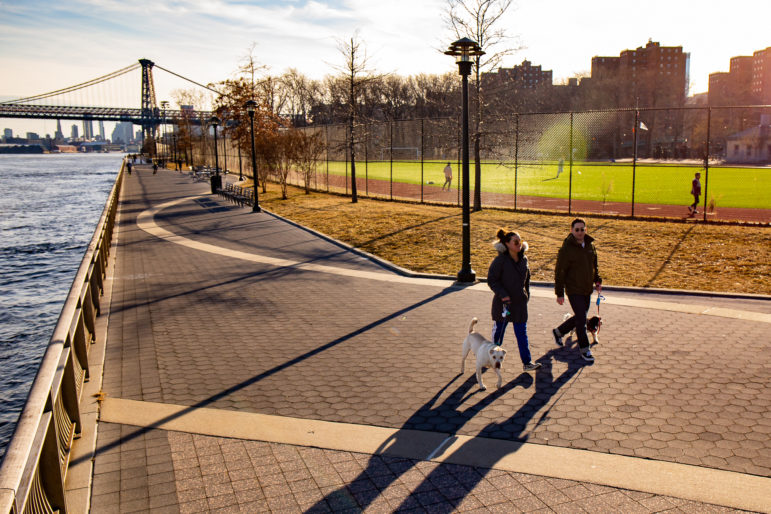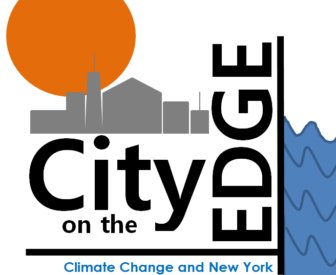
Adi Talwar
The East River Promenade on a mid February weekend afternoon. Community members and the de Blasio administration are wrestling over how to shore up coastal defenses in the area.
Almost seven years have passed since Hurricane Sandy left its mark in the city. Neighborhoods like the East Village and Lower East Side were severely impacted by flooded streets and loss of electric power. Beyond the loss of life and the price of rebuilding, the storm also delivered a warning about what the city can expect as sea levels rise.
A study conducted by several American institutions suggested rising sea levels makes the city vulnerable to floods that will happen every five years after the year 2030.
Flooding can be damaging to the city’s infrastructure and economy, which is why the city and federal resources are currently being hauled together to protect the city through two flood protection initiatives – the East Side Coastal Resiliency Project and the U.S. Army Corps of Engineers’ New York and New Jersey Harbor Tributaries Study.
As these initiatives start to come to fruition, skepticism continues to surround the projects over funding and their capability to protect New York City’s vulnerable coastal communities.
The East Side Coastal Resiliency Project (ESCR)
In 2014, the U.S. Department of Housing and Urban Development’s Rebuild by Design competition awarded the city $335 million to fund the first phase of a flood protection initiative in Lower Manhattan, called the Big U, which involves rebuilding the East River Park. The city provided an additional $425 million to the project, bringing the cost of total funding to $760 million.
The project targets the area along East 25th street down to Montgomery Street and originally included berms, levees and a floodwall adjacent to the FDR Drive. But in a twist of events, the City announced in September an overhaul of the project with drastic changes.
Get the best of City Limits news in your inbox.
Select any of our free weekly newsletters and stay informed on the latest policy-focused, independent news.
The new design covers the area up to East 13th street (the project will remain unchanged up to East 25th street) and elevate the park by eight to ten feet. The redesign also moves the floodwall underground from its original placement. Mayor Bill de Blasio’s administration claimed these adjustments will implement flood protection a year early, reduce construction time by six months and be less disruptive for nearby residents as it moves construction closer to the waterfront. These changes increased the cost to a hefty $1.45 billion and prompts the closure of the park for three and a half years.
Feeling deceived by the sudden modifications, residents like Dianne Lake expressed their frustration with the city’s lack of communication at a City Council committee hearing last month. “We’ve been presented with a hastily assembled proposal that was done more or less in the dead of night without any warning,” said Lake.
The NYC Department of Parks and Recreation and Department of Design and Construction (DDC) were under scrutiny at the committee hearing, where it was pointed out that additional funding had yet to be allocated. But at a Community Board 3 meeting last week, an official from DDC announced the City will provide the rest of capital funding. No details were provided when asked for the origins of the money.
Construction on the project could begin in spring 2020 if it is certified by the city’s uniform land use review procedure (ULURP) this year and receives approval from council member Carlina Rivera, whose district includes East Village and Lower East Side.
U.S. Army Corps of Engineers Weighing In
Aside from the ESCR project, the U.S. Army Corps of Engineers is also planning to implement additional flood protection in the New York harbor. In 2017, it released five proposals for storm-surge protection to be analyzed in its New York and New Jersey Harbor Tributaries Study (NYNJHATS).
The proposals ranged from shoreline protections to large storm-surge barriers meant to prevent flooding during a storm. These barriers would be placed between Breezy Point, Queens and Sandy Hook, New Jersey and another between the Bronx and Queens.
Robert Freudenberg, vice president of Regional Plan Association’s energy and environmental program, has seen other cities pursue barriers for flood protection (Boston has contemplated a surge barrier of their own but a feasibility study advised against it). But he said questions remain unanswered on how the costs of building a barrier align with the benefits.
“I think that alternative has always been interesting because it can protect such a large area,” said Freudenberg, “but I think we have always called for there to be more studies on that option because we need to know what potential impacts are for the benefit it provides.”
But the plan for a storm-surge barrier came as a surprise for John Lipscomb, vice president for advocacy at Riverkeeper. “Every way you look at this it is a bone-headed idea,” said Lipscomb. For Riverkeeper, such barriers are a short-term solution for storm-surge, but it ignores the greater risk of sea level rise. Spending billions of dollars on a project like this is “crazy for society,” said Lipscomb.
Skepticism over such barriers was brought up in a 2013 study by the New York City Economic Development Corporation, calling it a “silver bullet” solution. In theory, the barriers can block storm surges but it would “pose significant risks to the city that far outweigh its theoretical benefits.” The study explains barriers would be left open under normal weather conditions to allow navigation but would “end up doing nothing” to resolve the problem of rising sea levels.
The Army Corps will release an interim report on the NYNJHATS tomorrow and public meetings will be held in March and April. A final report will be due in spring 2021 and the following year the Army Corps chief will recommend the chosen proposal to Congress, who will authorize funding for construction.
These two are the most high-profile resiliency projects in our area, but other efforts are underway, like the Red Hook Integrated Flood Protection System and the Hunts Point Peninsula Resiliency and Energy Pilot Project. You can keep track of other projects in this interactive map provided by the city.
In the meantime, nature will not wait as the city considers the changes to the ESCR project and the Army Corps deliberates proper harbor protection. At the recent CB3 meeting, one attendee singled out the absence of flood protection during ESCR project’s construction. “I have heard nothing about what is going to happen during construction if a storm like Sandy or worse comes along,” she asked. “How will we be protected?”
An official from DDC mentioned the city currently has interim flood protection measures. The city’s office of Emergency Management handles the Interim Flood Protection Measures program in collaboration with the Mayor’s Office of Recovery and Resiliency and other city agencies to protect neighborhoods across the city. “I know that is in talks but I don’t want to speak to that,” said the official. “That is why we want to accelerate the construction period.”










2 thoughts on “Key Moment for NYC’s Post-Sandy Flood Protection Plans”
Pingback: EVG Etc.: The Strand's landmark battle; Cooper Union's Chrysler Building situation ⋆ New York city blog
Pingback: Key Moment for NYC’s Post-Sandy Flood Protection Plans - Riverkeeper